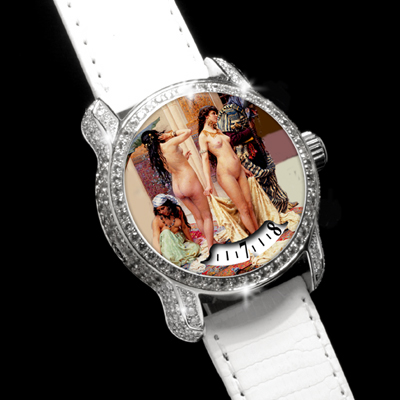Up one level
- Beauty & Glamour - Verre Èglomisè Tiger
- Ancient Flower Bouquets - Aperture 6 o'clock
- Ancient Flower Bouquets aperture 12 o'clock
- Beauty & Glamour - Scenes from the Harem
- Beauty & Glamour "Mona Lisa"
- Beauty & Glamour - Red Peony
- Beauty & Glamour - Pink Peony
- Beauty & Glamour - White Peony
- Beauty & Glamour - A ancient blue flower bouquet
- Beauty & Glamour - TuttiFrutti
- Beauty & Glamour "Magnificent Blossoms"
Beauty & Glamour - Scenes from the Harem
Description:
Beauty & Glamour - Scenes from the Harem
Circular stainless steel case with integrated lugs, mechanical self-winding movement with enameled rotor, screw-locked crown with logo inlaid in black enamel, screwed display back, pavée setting with 4,4 ct, TW/VVS brilliants, miniature painting on the reverse of the 62.7 ct. sapphire crystal.
Case diameter 42.00 mm
In July of 1798 Napoleon marched into Egypt with an army. He defeated the Turks at the battle of the Pyramids, stayed for a few weeks and then was driven out by the British. In the small amount of time that he was there he managed to do what he did best: he changed everything.
Following him came first a trickle and then a torrent of westerners into the Near and Middle East. The writers who wrote about their experiences and the artists who painted what they saw became known as the Orientalists. They traveled through Turkey, Iraq, Persia, Egypt, Lebanon, Palestine, Arabia and North Africa. With time this became an art movement and today we call it Orientalist art.
This movement spanned over a century and included hundreds of known artists. Many of them were giants of the art world and created beautiful paintings that seem almost photographic in detail. Many of them took incredible risks and endured considerable hardship. Disease was the greatest hazard and gun battles with bandits were commonplace. At other times they were received with the greatest kindness and made lasting friendships.
They came from all over the world: from England, France, Belgium, Germany, Italy, Russia, America, and Australia. Some of them specialized in landscapes, in archeological themes, or in people. Some of them were very religious and created biblical scenes, some specialized in military history. Others recorded the flora and fauna of the Near and Middle East. Encompassing many different painting styles and political leanings, the only generalization that can be made about them is that they were extremely diverse.
Baths were and are an important part of life going back centuries. The Babylonians, Greeks, and Romans all were known for their public baths and luxurious bath houses were built all through the Near and Middle east.
Western artists were frequently shown the inside of these beautiful baths, absent the women. From sketches and photographs they would then reconstruct the scene in their studios, often using professional models.
Accurate detail and authenticity were extremely important to them. The curious shoes in the lower right of the picture were designed to provide traction and to lift the wearers feet off the floor and out of the soaps and chemical depilatories that they used to remove body hair.
Artists have always delighted in nudes. This painting reminds us of a time when beautiful hair and skin were more important than thinness.
Life in harems were full of elaborate affairs and rituals. Status was extremely important to the women and they often competed with each other in clothing and possessions. Male artists were not allowed into harems but western women were and they provided the descriptions of the activities that went on inside.
